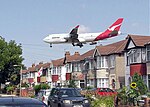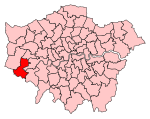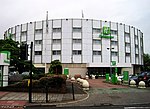Hatton Cross tube station

Hatton Cross is a combined London Underground station and bus station. It is located on the Heathrow branch of the Piccadilly line. It is in Travelcard Zones 5 and 6 and stands between the Great South West Road (A30) and the Heathrow Airport Southern Perimeter Road. The station serves a large area including Feltham to the south and Bedfont to the west. The station was named after the crossroads of the Great South West Road and Hatton Road. The station, itself in the borough of Hillingdon, serves a very small residential community in Hatton, which is in the borough of Hounslow. The nearby area is partly within the airport but mainly includes its associated commercial warehousing and light industrial premises. "Hatton Cross" refers to the crossroads on the former coaching road leading south west, and is now applied to the overlying major road intersection immediately south east of the station. Hatton Cross is also the nearest underground station to the popular plane spotting location of Myrtle Avenue, and for this reason is commonly used by plane spotters travelling to the area.
Excerpt from the Wikipedia article Hatton Cross tube station (License: CC BY-SA 3.0, Authors, Images).Hatton Cross tube station
Southern Perimeter Road, London
Geographical coordinates (GPS) Address Nearby Places Show on map
Geographical coordinates (GPS)
| Latitude | Longitude |
|---|---|
| N 51.466944444444 ° | E -0.42333333333333 ° |
Address
Southern Perimeter Road
TW6 3AE London (London Borough of Hillingdon)
England, United Kingdom
Open on Google Maps






